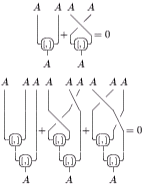 | ||
In mathematics, a Lie superalgebra is a generalisation of a Lie algebra to include a Z2-grading. Lie superalgebras are important in theoretical physics where they are used to describe the mathematics of supersymmetry. In most of these theories, the even elements of the superalgebra correspond to bosons and odd elements to fermions (but this is not always true; for example, the BRST supersymmetry is the other way around).
Contents
Definition
Formally, a Lie superalgebra is a (nonassociative) Z2-graded algebra, or superalgebra, over a commutative ring (typically R or C) whose product [·, ·], called the Lie superbracket or supercommutator, satisfies the two conditions (analogs of the usual Lie algebra axioms, with grading):
Super skew-symmetry:
The super Jacobi identity:
where x, y, and z are pure in the Z2-grading. Here, |x| denotes the degree of x (either 0 or 1). The degree of [x,y] is the sum of degree of x and y modulo 2.
One also sometimes adds the axioms
Just as for Lie algebras, the universal enveloping algebra of the Lie superalgebra can be given a Hopf algebra structure.
A graded Lie algebra (say, graded by Z or N) that is anticommutative and Jacobi in the graded sense also has a
Properties
Let
- No odd elements. The statement is just that
g 0 - One odd element. Then
g 1 g 0 a d a : b → [ a , b ] , a ∈ g 0 , b , [ a , b ] ∈ g 1 - Two odd elements. The Jacobi identity says that the bracket
g 1 ⊗ g 1 → g 0 g 1 - Three odd elements. For all
b ∈ g 1 [ b , [ b , b ] ] = 0 .
Thus the even subalgebra
Conditions (1)–(3) are linear and can all be understood in terms or ordinary Lie algebras. Condition (4) is nonlinear, and is the most difficult one to verify when constructing a Lie superalgebra starting from an ordinary Lie algebra (
Involution
A ∗ Lie superalgebra is a complex Lie superalgebra equipped with an involutive antilinear map from itself to itself which respects the Z2 grading and satisfies [x,y]* = [y*,x*] for all x and y in the Lie superalgebra. (Some authors prefer the convention [x,y]* = (−1)|x||y|[y*,x*]; changing * to −* switches between the two conventions.) Its universal enveloping algebra would be an ordinary *-algebra.
Examples
Given any associative superalgebra
and then extending by linearity to all elements. The algebra
The Whitehead product on homotopy groups gives many examples of Lie superalgebras over the integers.
Classification
The simple complex finite-dimensional Lie superalgebras were classified by Victor Kac.
The basic classical compact Lie superalgebras (that are not Lie algebras) are: [1]
SU(m/n) These are the superunitary Lie algebras which have invariants:
This gives two orthosymplectic (see below) invariants if we take the m z variables and n w variables to be non-commutative and we take the real and imaginary parts. Therefore, we have
SU(n/n)/U(1) A special case of the superunitary Lie algebras where we remove one U(1) generator to make the algebra simple.
OSp(m/2n) These are the Orthosymplectic groups. They have invariants given by:
for m commutative variables (x) and n pairs of anti-commutative variables (y,z). They are important symmetries in supergravity theories.
D(2/1;
for particular constants
F(4) This exceptional Lie superalgebra has dimension 40 and is a sub-algebra of OSp(24|16). The even part of the group is O(3)xSO(7) so three invariants are:
This group is related to the octonions by considering the 16 component spinors as two component octonion spinors and the gamma matrices acting on the upper indices as unit octonions. We then have
G(3) This exceptional Lie superalgebra has dimension 31 and is a sub-algebra of OSp(17|14). The even part of the group is O(3)×G2. The invariants are similar to the above (it being a subalgebra of the F(4)?) so the first invariant is:
There are also two so-called strange series called p(n) and q(n).
Classification of infinite-dimensional simple linearly compact Lie superalgebras
The classification consists of the 10 series W(m, n), S(m, n) ((m, n) ≠ (1, 1)), H(2m, n), K(2m + 1, n), HO(m, m) (m ≥ 2), SHO(m, m) (m ≥ 3), KO(m, m + 1), SKO(m, m + 1; β) (m ≥ 2), SHO ∼ (2m, 2m), SKO ∼ (2m + 1, 2m + 3) and the five exceptional algebras:
The last two are particularly interesting (according to Kac) because they have the standard model gauge group SU(3)×SU(2)×U(1) as their zero level algebra. Infinite-dimensional (affine) Lie superalgebras are important symmetries in superstring theory.
Category-theoretic definition
In category theory, a Lie superalgebra can be defined as a nonassociative superalgebra whose product satisfies
where σ is the cyclic permutation braiding
